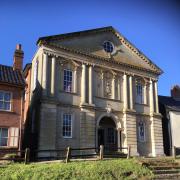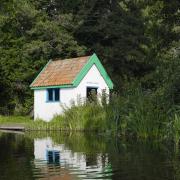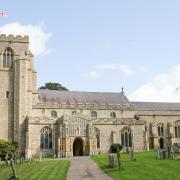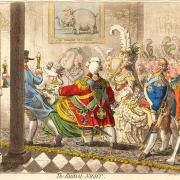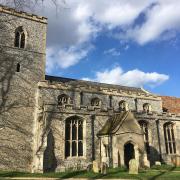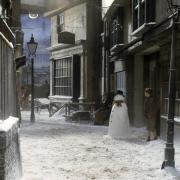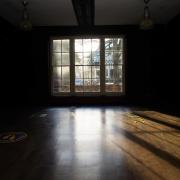Lindsay Want follows a footpath or two through Suffolk’s wealth of historic parklands

Looking for a satisfying stroll? Well, you’d think that would be a real walk in the park in Suffolk.
Truth is though, when it comes to parklands, we’re simply spoilt for choice. Head for the coast, countryside or opt to stay in town and historic halls plus time-honoured estates are just around the corner, or at least subtle indicators or reminders of them are.
In the village of Easton, Europe’s longest crinkle-crankle wall circles the spot of one of Suffolk’s lost ‘Great Houses’. At Campsea Ashe it’s rusty railings, on the Ipswich ring road near Tuddenham, the smallest suggestion of a tree-lined avenue is the only memory of the much-renowned Red House.
Elsewhere from the ridges above the Stour to rolling Mid-Suffolk and beyond, halls hang on in there and priceless pockets of medieval hunting grounds, landscaped pleasure gardens, deer runs and woodland rides remain intact. Nothing seems to have crossed their paths for centuries. But the paths are certainly there and many are designated public rights of way – free tickets to explore the secret worlds of Suffolk. So where on earth do you start?

Ask a local lad
Sir Humphry Repton, one of England’s most renowned landscape designers after ‘Capability’ Brown, hailed from Bury St Edmunds. Associated with prestigious gardens and parklands such as Woburn Abbey, Longleat and Holkham Hall, the minor squire came to gardening relatively late in life, but enjoyed some of his earliest commissions in his home county.
Park up and stride out from Coddenham village hall near Needham Market and beyond the churchyard, to 17th century redbrick Hemingstone Hall, en route to Old Hall on the ridge above the River Gipping, an estate originally owned by Robert de Shrubeland.
Repton’s 1788 ‘Red Book’ of proposals for the park here includes a sketch of the fine 16th century hall, but by that time Sir William Middleton had already set about building the new Italianate Shrubland Hall on higher ground whose pinnacles now just peek above the trees.
These days, the ‘new’ hall may be out of reach, but footpaths edge Old Hall’s historic fish pond, the humble remains of the house (demolished in the 1900s, but rebuilt retaining the old chapel) and Repton’s deerpark. The massive vintage sweet chestnut trees either side of the path through ‘The Warren’ must have already been impressive even back in the grand designer’s times, and he would surely have approved of today’s enchanting pond and path-side view of the Rapunzel-style tower, Old Hall Estate’s cleverly disguised water-tower.
Go to church
St Mary’s at Stoke by Nayland is a fine place to start a right old ramble taking in three or more historic halls sites, including one with parklands courtesy of Sir Humphry. From close by the recreation ground car park the Stour Valley Path leads this way or that to meet more footpaths, introducing 18th century Scotland Hall, the grounds of Grade I listed Gifford’s Hall and the idyllic Repton parklands of the long lost, early John Soane mansion, Tendring Hall. Styled in 1791 for Sir William Rowley, Tendring Hall Park has to be one of Suffolk’s most picturesque, a classically sculpted landscape between the River Box and River Stour valleys.
At Coombs near Stowmarket, a footpath from St Mary’s seems to lead further afield. Westend Farm and Little London are in the near distance, but at an isolated estate church loop down to the B1113 and back up along Badley Walk, the original avenue leading to Badley Hall. At open grassland, the last remaining section of Edmund Poley’s 16th century mighty courtyard complex comes into view. Coombs Hall was not so fortunate, but just beyond the ancient woodland near Coombs Church are the intriguing earthwork remains of Orlando Bridgeman’s formal 1720 gardens.
Sudbourne All Saints Church near Orford is the place to park for ancient woodland and exotic parkland all in one puzzling package. Cut through Tunstall Forest towards the village and follow paths near the old school to Captain’s Wood, the former hunting grounds for medieval bishops and today, a top spot for seeing fallow deer and maybe even a white hart. Here, you’ll find hazel, holly and sweet chestnut among some pretty impressive oaks, plus clumps of scots pine and bright rhododendrons.
Over at Helmingham Church, footpaths lead through the deer park past the Tudor moated hall with its famous gardens, while a wander from Wantisden Church across to Staverton Park near Rendlesham Forest offers the ultimate Elizabethan hunting ground experience. Known as ‘The Thicks’, the dense area of ancient pollarded oaks is one truly Tolkienesque landscape!
Check out a picnic place
The Teaparty Oak is just a few steps away from the carpark at Ickworth Park near Bury St Edmunds (small admission charge, National Trust members free). Enjoy a quick once round the deer enclosure or maybe the Grand Tour past Ice House and Iron Pillars, Obelisk and Fairy Lake.
At Thornham Walks near Eye, are woodland worlds of wide parkland ‘rides’ and walled gardens, but the historic hall is sadly no more. Haverhill’s East Town Park has similar tales to tell, whilst Nowton Park near Bury St Edmunds keeps its house quite hidden away.
Head to the pub
Long Melford’s magnificent green is a great place to picnic and potter, unless you have a thirst for something else of course. There are several inns to choose from near Melford Park, once the hunting estate for Bury Abbey’s monks.
Drink in the atmosphere of one of Suffolk’s best loved wool towns, then weave your way past Holy Trinity Church, following footpaths towards the grand gates of Tudor masterpiece, Kentwell Hall, and on through the park and farmlands towards Ashen Grove and Bridge Street. Chad Brook and Crabtree Wood lead back towards Melford Hall where ‘Hare Drift’ edges the park, bringing you back to a pub and Long Melford’s green.
Visit a museum or two
Christchurch Mansion in the centre of Ipswich not only has Suffolk landscapes by Constable and Gainsborough to admire for free, but its extensively terraced hillside parklands make interesting walks on all sorts of levels. With bowling greens and bandstands, ponds and play areas, swans and squirrels there’s something for everyone.
Abbotts Hall in the centre of Stowmarket is a fascinating free museum. Walks through its walled gardens and parklands, past the picturesque little fishing lodge down to the River Rat are accessed through the adjacent Museum of East Anglian Life.




